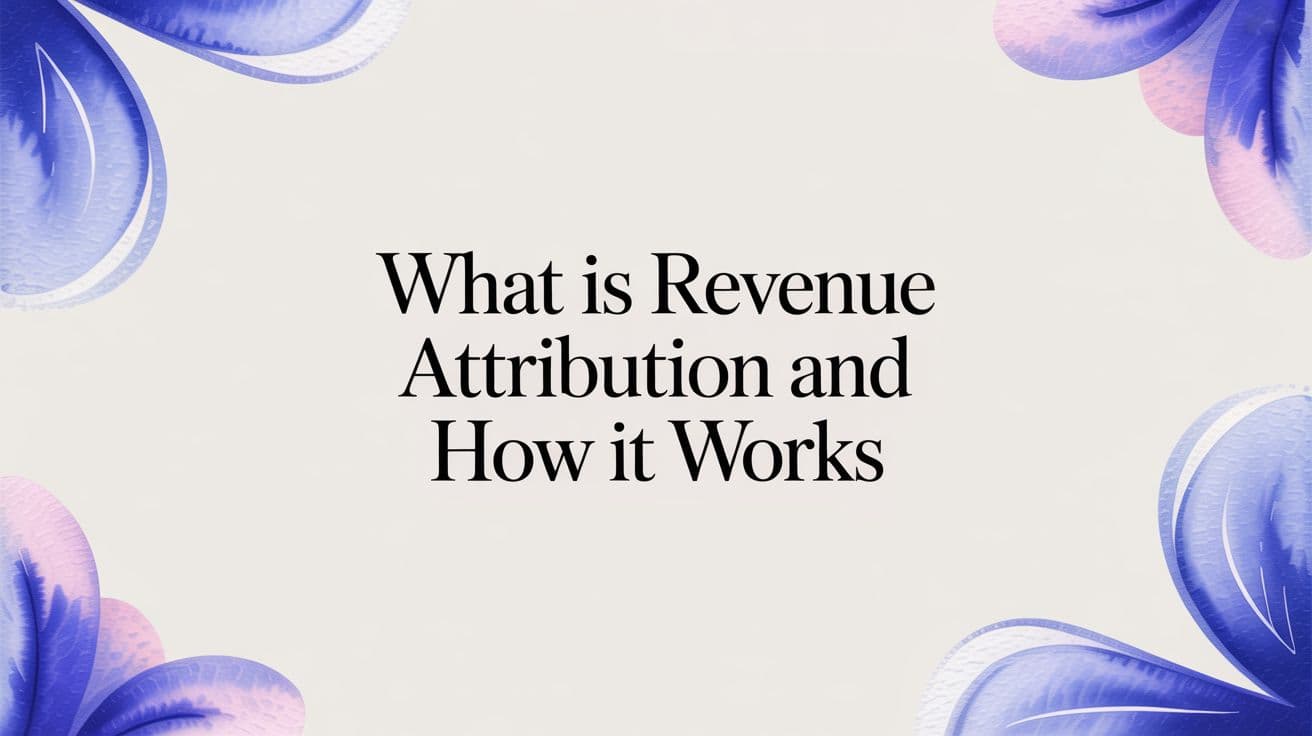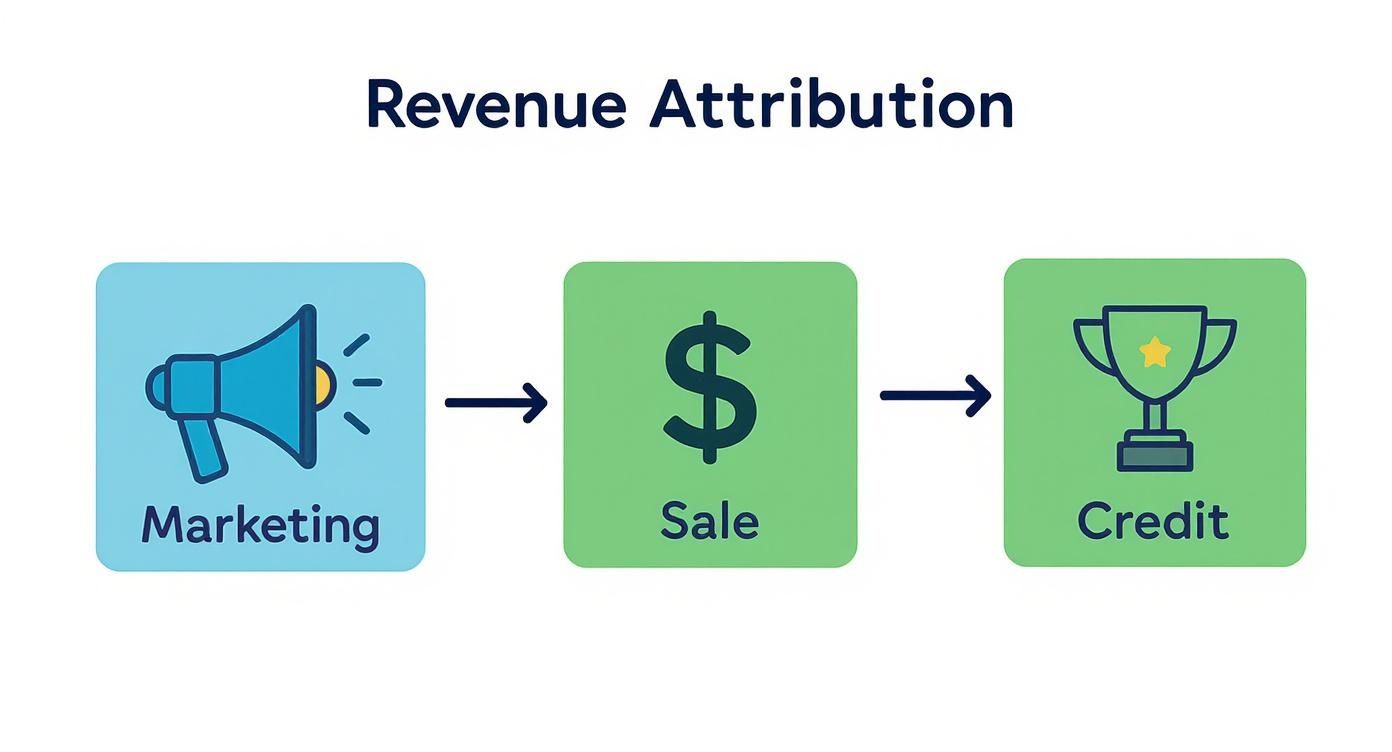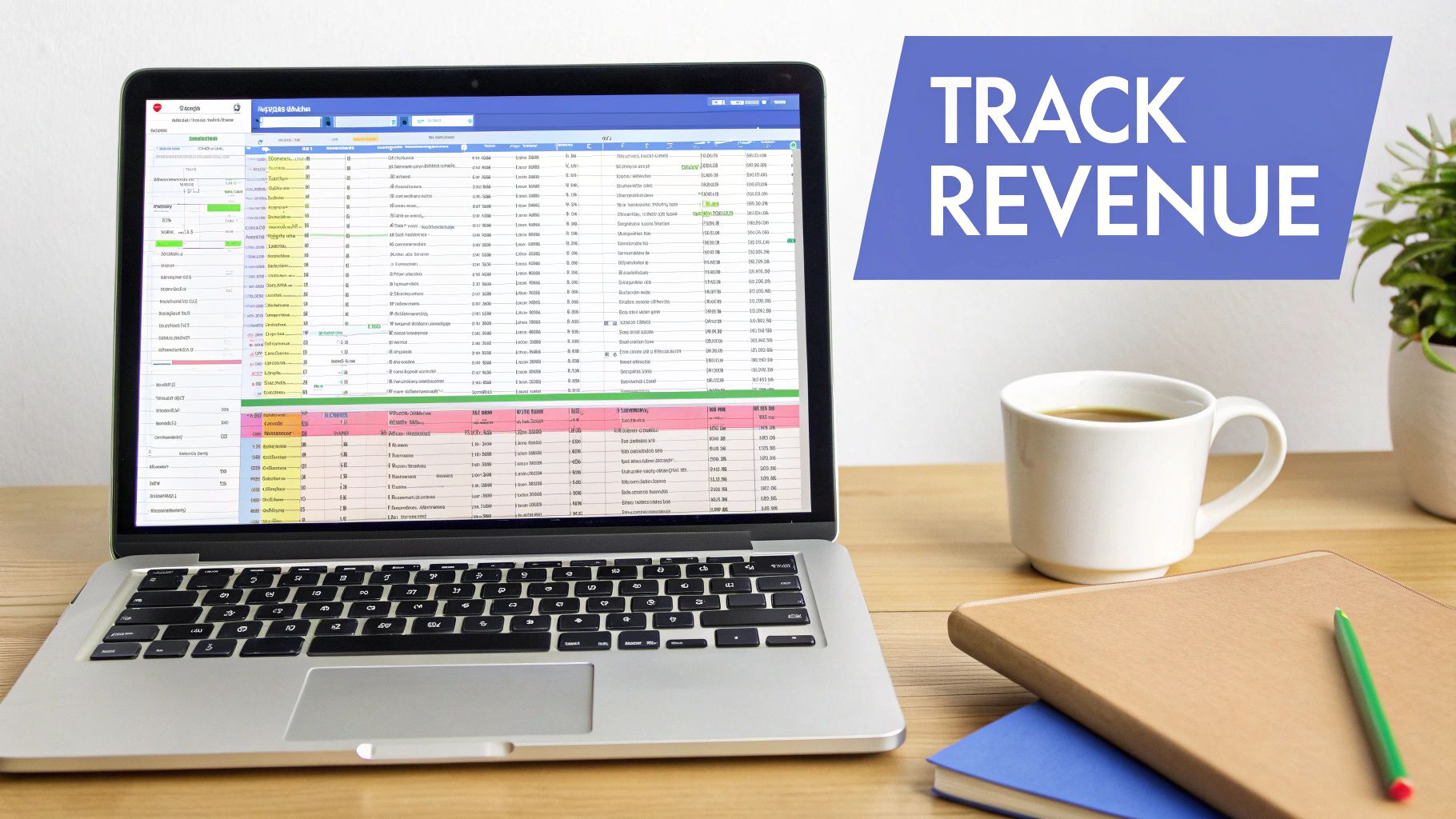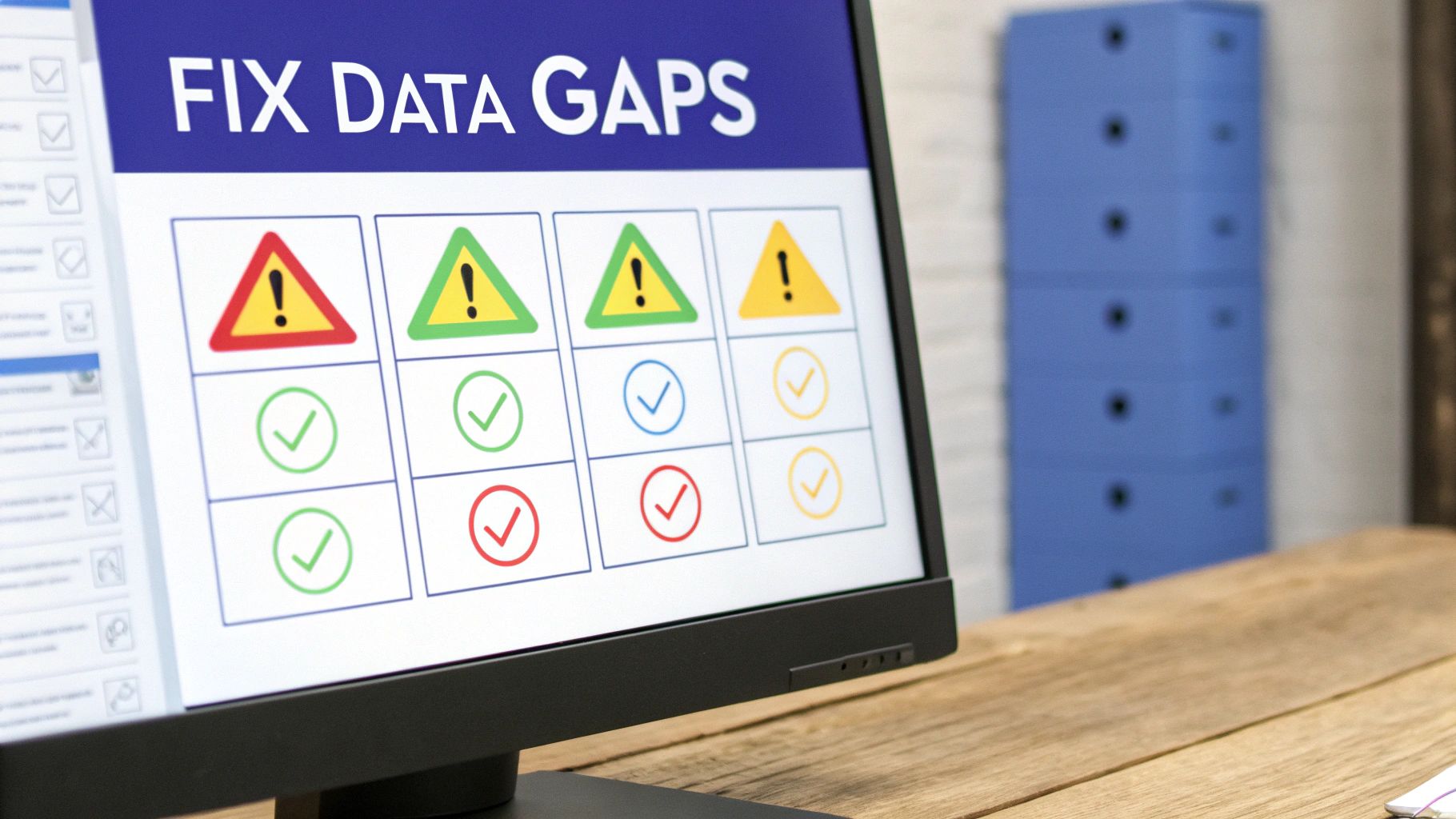What Is Revenue Attribution and How It Works
What Is Revenue Attribution and How It Works
Ollie Efez
October 27, 2025•12 min read

Ever wonder which blog post, ad, or email actually convinced a customer to finally pull out their credit card? That's the million-dollar question revenue attribution sets out to answer. It’s all about connecting the dots between your marketing efforts and the money that ends up in the bank.
Connecting Your Marketing to Real Revenue
Think of a customer's journey like a soccer team driving down the field. The striker who scores the goal gets all the glory, but what about the midfielder who made the perfect pass? Or the defender who started the play? Revenue attribution is like the game-day analyst, reviewing the tape to see how every single touch contributed to the final score.
It goes way beyond surface-level stats like clicks or impressions. Instead, it digs deep to show you which channels and campaigns are actually putting points on the board and driving sales.
Understanding this connection is the first step toward making smarter decisions with your marketing budget. It gives you a clear, undeniable picture of your financial impact. For a deeper dive into the basic principles, check out this guide on What Is Revenue Attribution: Key Insights & Benefits.
Why Attribution Matters Today
Without a solid attribution model, you're essentially flying blind. You might be pouring money into channels that feel busy and look good on paper but don't actually move the needle on revenue. With proper tracking, you can finally answer the tough questions:
- Is our organic social media content bringing in high-value customers, or just vanity metrics?
- Are our Google Ads actually delivering a positive return on investment?
- Which of our email nurture sequences is a true conversion machine?
The results can be pretty dramatic. For example, the tour company Walks of Italy built a data-driven attribution model and saw a 33% increase in revenue. Not only that, but they also boosted transactions by 31% and saw a 25% jump in ROI. Getting a handle on the fundamentals of attribution is your first step toward achieving that kind of clarity and growth.
How Different Attribution Models Work
Deciding which marketing touchpoint gets the credit for a sale is rarely a simple affair. Think of it like a relay race—does the runner who started the race get all the credit, the one who ran the final leg, or everyone who carried the baton? Marketers use different attribution models to answer this question, each with its own way of judging which interactions mattered most.
These models typically fall into two buckets. The simplest are single-touch models, which give 100% of the credit to one specific interaction in the customer’s journey. It's a straightforward approach, but it can miss the bigger picture of how most people actually decide to buy something.
This infographic breaks down how attribution connects the dots between your marketing efforts and actual sales.

As you can see, revenue attribution is the glue that links what you spend on marketing to the final sale, showing you which campaigns truly earned their keep.
Single-Touch Attribution Models
The two most common single-touch models give you a very clear, but admittedly narrow, view of performance. They work best for businesses with short sales cycles or for campaigns with very specific goals.
- First-Touch Attribution: This model gives all the credit to the very first interaction a customer had with your brand. It’s fantastic for figuring out which channels are your best lead generators and are bringing new people into your world. We have a full guide that goes deeper into first-click attribution.
- Last-Touch Attribution: The opposite of first-touch, this model gives all the glory to the final touchpoint before the customer converted. This helps you see which channels are most powerful at closing deals.
Multi-Touch Attribution Models
While simple is sometimes good, single-touch models don't tell the whole story. Let's be real—most customers don't see one ad and immediately buy. They browse, they compare, they click around. That's where multi-touch attribution models come in, spreading the credit across several different interactions.
By looking at multiple touchpoints, you get a much more realistic view of your entire marketing funnel. It helps you value the channels that assist sales, not just the ones that land the final punch.
To give you a clearer idea, here’s a quick rundown of the most common attribution models.
Comparing Revenue Attribution Models
Choosing the right model from this list depends entirely on what you want to learn about your marketing.The shift toward data-driven marketing has made these more sophisticated multi-touch attribution models incredibly popular. In fact, the market for this technology is projected to grow to $7.08 billion by 2035, a huge leap from $1.76 billion in 2024. It’s clear that understanding the complete customer journey is no longer a "nice-to-have"—it's a necessity.
Choosing the Right Attribution Model for Your Business
https://www.youtube.com/embed/U4mOndKRins
So, you know the different models, but how do you actually pick the right one for your business? It’s a common stumbling block, but here’s the secret: there's no single "best" model. The right choice is the one that lines up with your unique sales process and what you’re trying to achieve.
To get started, think about your customer's journey. How long does it usually take for someone to go from a curious visitor to a paying customer? Do they bounce between your blog, social media, and email list before finally making a purchase? Your answers to these questions will start to narrow down the options pretty quickly.
Take a direct-to-consumer brand selling trendy apparel. Their sales cycle is often short and sweet. A customer sees an Instagram ad, clicks, and buys in the same session. In a case like that, a simple Last-Touch model might be all you need to understand what's driving sales.
Aligning Models with Your Business Type
But what about a B2B SaaS company? Their sales process can stretch over six months, involving demos, multiple sales calls, and convincing a whole team of decision-makers. If they only looked at the final touchpoint, they'd completely miss the blog post or webinar that first caught the prospect's eye months earlier.
Here’s a simple way to connect your goals to a model:
- Need more leads? A First-Touch model is fantastic for showing you which channels are the best at filling the top of your funnel with fresh prospects.
- Want to close more deals? The Last-Touch model shines a light on the final push—what marketing efforts are most effective at getting people to sign on the dotted line.
- Looking for a holistic view? A Linear or U-Shaped model gives credit where it's due, recognizing the importance of both the first introduction and the final nudge, plus everything in between.
Choosing a model really comes down to what you want to learn. Are you trying to discover brand new audiences, or do you want to perfect the final steps that lead to a conversion? Your goal is the lens that will bring your revenue attribution into focus.
Putting Revenue Attribution into Practice

Knowing the theory is one thing, but making revenue attribution work for you is where the real value lies. Getting started is often less complicated than it seems. It all boils down to one foundational element: clean, reliable data.
The most common way to get that data is by using UTM parameters. Think of these as little breadcrumbs you attach to your URLs. They tell your analytics tools precisely where a visitor came from—whether it was a specific email campaign, a Facebook ad, or a blog post link.
Making UTM tracking a mandatory step for every campaign is crucial. Without it, you’re just guessing. With it, you're building a detailed map of every single customer journey.
Building Your Attribution Toolkit
Once you have data coming in, you need the right tools to make sense of it all. You don't have to break the bank on a complex system right away; many of the platforms you're already using have powerful features baked right in.
Here’s where you can start looking:
- Google Analytics: A great entry point. It offers several basic attribution models that show how different channels are contributing to your website goals.
- CRM and Marketing Automation Platforms: Tools like HubSpot often provide more advanced reporting, letting you connect specific marketing activities directly to sales opportunities and closed deals.
- Dedicated Software: For a much deeper dive, specialized platforms offer sophisticated multi-touch models and integrate with your entire tech stack. Finding the right fit is key, which is why we've put together a guide on the best affiliate tracking software to help you weigh your options.
The trick is to pick a tool that fits where you are right now. You can always upgrade to a more powerful solution as your needs and your team’s understanding grow.
Ultimately, getting attribution right is a team sport. Your marketing and sales departments need to be on the same page about what counts as a "conversion" and which goals matter most. This shared clarity is what makes the data truly valuable.
The demand for this kind of insight is exploding. In fact, the U.S. market for attribution software is projected to soar past $41 billion by 2035. If you want to dig into the numbers behind this trend, you can explore more market forecasts and see how it's shaping modern marketing.
Navigating Common Attribution Hurdles

Choosing a revenue attribution model is a great first step, but the real work starts when you apply it to the messy, unpredictable world of customer data. Let's be honest: the path from a person's first click to their final purchase is rarely a straight line. Getting a clear view means you have to anticipate and tackle a few common roadblocks.
One of the biggest headaches is cross-device tracking. Think about your own habits. You might see an ad on your phone while scrolling Instagram, do some research on your work laptop later, and finally pull the trigger on your tablet at home. To your attribution model, that can look like three separate people, completely breaking the story of that one customer's journey.
Then there's the whole world of offline interactions. What about that podcast sponsorship you ran? Or the conversation a lead had with your team at a trade show? If a sale is influenced by something that didn't happen online, a purely digital model won't see it. These blind spots can seriously warp your understanding of what's actually driving revenue.
Practical Solutions to Attribution Roadblocks
The good news is that these challenges aren't deal-breakers. With a few smart strategies, you can iron out the wrinkles in your data and get a much more accurate picture.
Here are a few ways to start cleaning things up:
- Clean Your Data: This is ground zero. Get everyone on the same page with a standardized system for UTM parameters. Regularly check your data for weird inconsistencies or errors. Solid attribution is built on a foundation of clean data.
- Bridge the Device Gap: Look into identity resolution tools that help connect the dots. Even something as simple as encouraging customers to create an account or log in can stitch together their activity across different devices into one unified profile.
- Track Offline Conversions: You can bring offline touchpoints into the digital fold. Use unique coupon codes for a podcast ad, set up a dedicated phone number for a mailer, or add a simple "how did you hear about us?" field to your checkout form.
The goal isn't perfection—it's progress. Every step you take to clean up your data and account for complex journeys brings you closer to making genuinely data-driven decisions that impact your bottom line.
Answering Your Revenue Attribution Questions
What's the difference between single-touch and multi-touch attribution?
Think of it like a soccer game. Single-touch attribution gives 100% of the credit to the player who scored the goal. Multi-touch, on the other hand, recognizes the assists and passes from teammates that led to that goal.
- First-touch gives all the credit to the very first interaction, which is great for understanding what initially brings people into your world.
- Last-touch focuses on the final click before the sale, highlighting what closes the deal.
How often should I check on my attribution model?
Your customers' behavior is always changing, so your model can't be a "set it and forget it" tool. A good rule of thumb is to give it a quick check-up monthly and do a deeper dive every quarter.
This rhythm helps you stay agile. If a new social media channel suddenly starts driving a ton of conversions, you'll catch it early and can adjust your strategy accordingly.
- Look at basic data like weekly click reports to spot trends early.
- Schedule quarterly meetings with your team to review the big picture.
- Always plan to revisit your model after a major product launch or marketing campaign.
Is revenue attribution only for big companies?
Not at all. In fact, it can be even more critical for small businesses. When every dollar counts, you need to be absolutely sure your marketing budget is working as hard as possible.
Getting the Most from a Small Budget
The key is finding a tool that does the heavy lifting for you. For instance, LinkJolt provides a simple dashboard to see exactly where your affiliate revenue is coming from in real time. It automates reporting and handles fraud detection, so small teams can focus on what they do best: growing the business.
- You can get started without setup fees or transaction costs.
- Your affiliates get their own portal to see their performance, which keeps them motivated.
- You can set up flexible commissions that fit your specific goals and budget.
On average, small businesses that start using revenue attribution see their ROI jump by up to 20% in the first three months.
Getting started is easier than you think. Just clarify your goals, start tagging your links properly (UTM parameters are your friend), and connect a tool like LinkJolt to your website.
This way, even a one-person team can quickly identify their star affiliates and double down on what’s working. It’s all about making smarter, data-backed decisions.Ready to see exactly what's driving your growth? Start tracking your revenue attribution with LinkJolt at https://linkjolt.io
Watch Demo (2 min)
Trusted by 100+ SaaS companies
Start Your Affiliate Program Today
Get 30% off your first 3 months with code LINKJOLT30
✓ 3-day free trial
✓ Cancel anytime